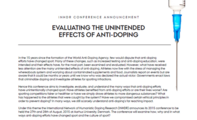December 2014
The Unleveling Landscape of Anti-doping
The changing seasons ushered in new aspects of anti-doping. In November, Rita Jeptoo, a marathon runner from Kenya, returned an out-of-competition control sample that tested positive for EPO. Jeptoo’s positive would be business as usual if not for the unusual circumstances surrounding her case. Not only was Jeptoo using a former doctor as her manager (a suspect relationship) but her positive test reminded the sporting world that athletes from countries like Kenya have posed challenges to WADA’s global anti-doping efforts. Not only is Kenya large with many remote outposts but it also lags in financial resources and anti-doping infrastructure. This has led to fears that Kenyan runners could take advantage of their country’s basically non-existent anti-doping system The fact that Jeptoo’s positive resulted not from a test performed by the Kenyan Anti-Doping Agency but by the International Association of Athletics Federations with financial support from the World Marathon Majors only furled suspicions that the two-tiered anti-doping enforcement resulted in an unleveled playing field (Pilon and Longman 2014).
The December 2014 editorial entiteld 'The Unleveling Landscape of Anti-Doping' is written by John Gleaves, California State University, Fullerton and Ask Vest Christiansen, Aarhus University.
Call For Papers

Pay attention to your inbox the coming weeks. The INHDR will soon announce its call for papers for the 2015 conference. The conference will take place in Aarhus, Denmark on the 27th and 28th August.
Doping Issuse In Japan

Anti-doping rules came into effect starting with the 1968 Winter and Summer Olympic Games, but it was long believed in Japan that there were no athletes who were intentionally using prohibited substances. Evidence of this was the fact that there were very few instances of doping violations by Japanese athletes after 1968. Because of this, the doping prevention movement was relatively inactive in Japan. What shocked Japanese sports organization was when Yoshitaka ITO, a track and field sprint athlete, tested positive during a random test in 1996. Methyltestosterone, a muscle-enhancing agent, was detected in his sample. Ito asserted his innocence, but he was subjected to a four-year loss of qualifications. This incident built momentum for establishing the Japan Anti-Doping Agency (JADA) in 2001, following the formation of the World Anti-Doping Agency (WADA) in 1999. According to WADA reports, the global positive rate is about 2%, but what is the rate in Japan?
Find the answer in Dr. Yoshitaka Kondo's enlightening commentary here
Anti-Doping 'On Steriods': Bigger, Stronger, and Faster

Anti-doping has evolved from a historically independent and un-coordinated movement to what is now a largely coherent and unified crusade, headed by the World Anti-Doping Agency (WADA) and inclusive of global government, national government and sport authorities. The growth of anti-doping has not been limited to size but the scope has evolved as the WADA has consistently called for and successfully accrued more powerful weapons in the doping fight. While doping controls within sport have been successively ratcheted up (Hoberman, 2012) our attention here is with the recent expansion of anti-doping beyond the boundaries of sport to target the traffickers of performance and image enhancing drugs (PIEDs) through the use of criminal justice mechanisms.
Retesting: Limits and Consequences

When I received the invitation to write a comment for the INHDR newsletter several themes emerged in my mind. Finally, I chose one over which I had no opportunity to write before and thought this could be a good opportunity to do so. That is, the implications and consequences of retesting athletes’ doping samples for their medal record and post-sport career
In his commentary Rodrigo Pardo draws attention to some important questions surrounding the practices of retesting athletes' samples many years after the sporting event at which they were taken. Read the full commentary here
German Documentary on Doping
As a special service, the INHDR in this newsletter wants to draw your attention to a German documentary that aired on Wednesday December 3 on channel ARD. The well-researched documentary, not only brings evidence of the astounding extent of organized doping in Russian elite sport. It also reveals the bribery connected to this which involves officials, athletes, federations, laboratories and even the Russian NADO. Even if your German is a bit rusty it is well worth your time.
Advanced Olympic Research Grant Programme
For those interested in seeking funding from the IOC, we would like to draw your attention to their "Advanced Olympic Research Grant Programme". The deadline for applications is 9 February 2015. For more information go here
New INHDR Members
The INHDR continues to expand its membership base. We now have 47 members of the network from Asia, Australia, Europe and North America. For this month we would like to welcome:
- Dominic Sagoe, University of Bergen, Norway
- Bertrand Fincoeur, University of Leuven, Belgium